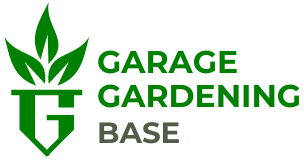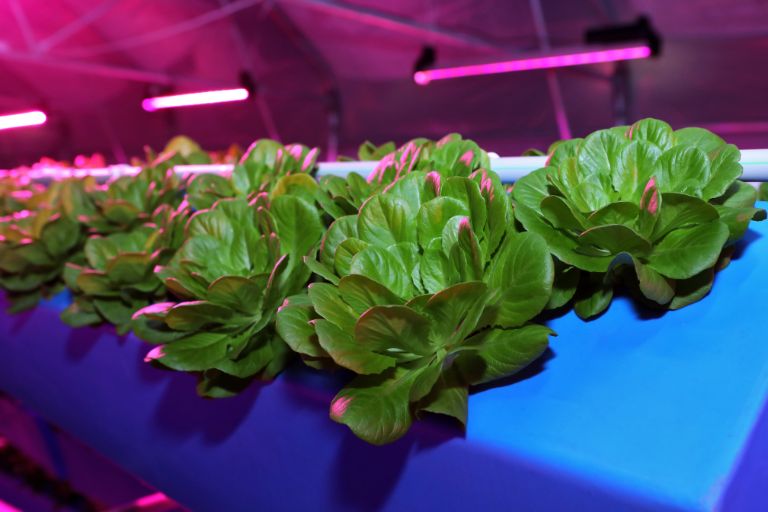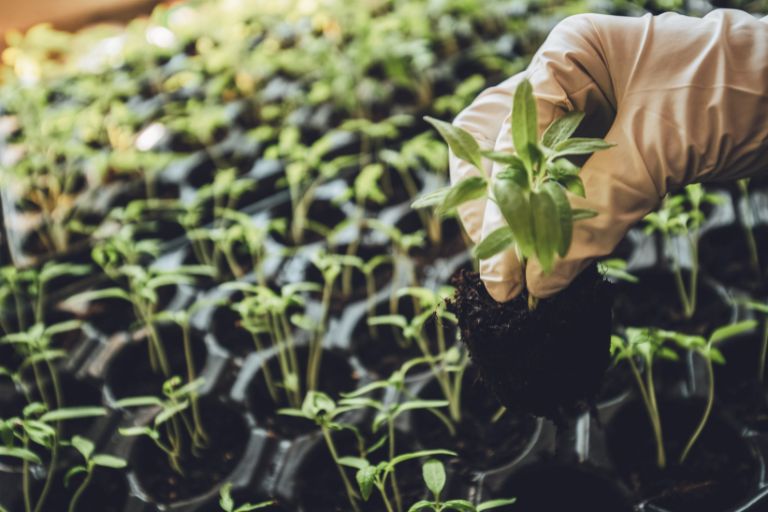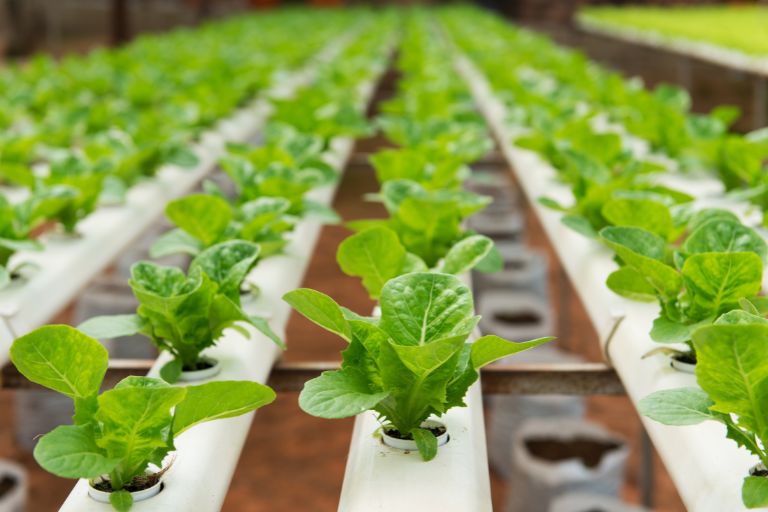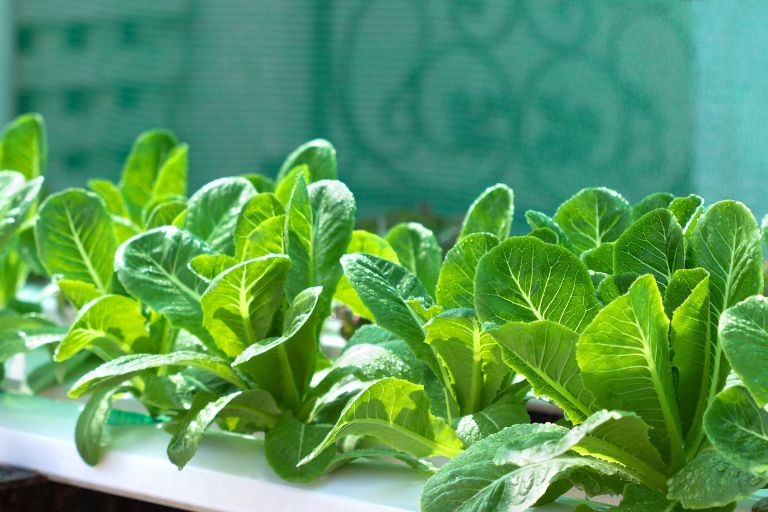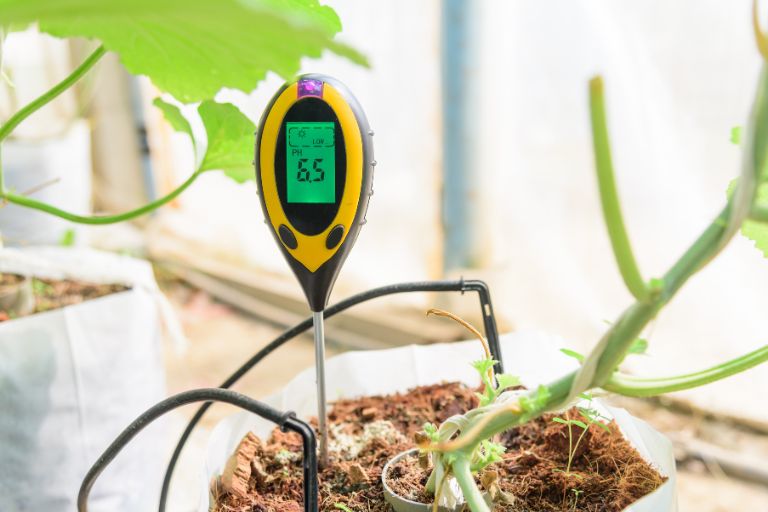Vertical Gardening in the Garage: How to Create a Thriving Indoor Garden

Vertical gardening in the garage is a type of indoor gardening that involves growing plants vertically, typically against a wall or in a freestanding shelving unit. This type of gardening is ideal for people who don’t have access to outdoor gardening space or who have limited space in their homes. Vertical gardening in the garage allows for efficient use of space, improved air quality and the ability to grow a wide variety of plants in a controlled environment. Using the right tools and techniques, anyone can create a thriving indoor garden in their garage that will provide them with fresh herbs and vegetables all year round.
Benefits of Vertical Gardening in the Garage
Vertical gardening is becoming increasingly popular due to its many benefits. Some of the benefits of vertical gardening in the garage include:
Maximizing Space – Vertical gardening is a great solution for those with limited outdoor or indoor space. By utilising vertical space, you can grow more plants in a smaller area, which is particularly useful for those living in apartments, condos or houses with small gardens.
Improved Air Quality – Plants are natural air purifiers and having more plants in your living space can improve the air quality in your home. Vertical gardening in the garage can help purify the air and create a healthier living environment.
Variety of Plants -Vertical gardening in the garage allows you to grow a variety of plants in a controlled environment. These include herbs, vegetables, flowers and even small fruit trees. With the right setup and care, you can grow almost any plant indoors, providing fresh produce and beautiful greenery all year round.
Easy Access – A vertical garden in your garage gives you easy access to your plants, making it easier to harvest herbs and vegetables when you need them. It can also help reduce waste by ensuring you only pick what you need.
Vertical gardening in the garage is an excellent option for those looking for a way to maximise space, improve air quality and grow a variety of plants indoors.
Vertical gardening in the garage is a great solution for those who have limited outdoor space or live in areas with harsh weather conditions. Some reasons why:
Limited Outdoor Space – For those living in apartments, condos or houses with limited outdoor space, vertical gardening in the garage offers a way to grow plants without taking up valuable floor space. This is particularly useful for those who want to grow their own produce but don’t have access to a garden or balcony.
Harsh Weather Conditions – In areas with harsh weather conditions, such as extreme heat, cold or frequent rain, gardening outdoors can be difficult or even impossible. Vertical gardening in the garage allows you to control the environment in which your plants grow, ensuring they have the right temperature, lighting and humidity levels.
Protection from Pests – Vertical gardening in the garage can protect your plants from outdoor pests such as insects and rodents, which can damage or destroy your plants. Indoor gardening allows you to monitor and control the environment in which your plants grow, reducing the risk of pest infestation.
Year-Round Growing – Vertical gardening in the garage allows you to grow plants all year round, regardless of the season. This is particularly useful for those who live in areas with a short growing season or who want to grow plants that are not native to their area.
Choosing the Right Plants
Vertical gardening in the garage provides a convenient and efficient way to grow plants for those with limited outdoor space or who live in areas with harsh weather conditions. By being able to control the environment in which your plants grow, you can ensure healthy and generous growth regardless of outside conditions.
There are several types of plants that thrive indoors and are well suited to vertical gardening in the garage. Below are a few examples:
Leafy Greens – Leafy greens such as lettuce, spinach and kale are excellent choices for vertical gardening in the garage. They grow well in cooler temperatures and thrive in low to medium light.
Herbs – Many herbs, such as basil, parsley and coriander, grow well in vertical gardens. They don’t take up much space and can add delicious flavour to your meals.
Strawberries – Strawberries are a great option for vertical gardening in the garage, as they can be grown in hanging baskets or in a wall-mounted system. They prefer cooler temperatures and plenty of light.
Succulents – Succulents are low-maintenance plants that can be grown vertically in small spaces. They come in a variety of shapes and sizes, making them a great way to add visual interest to your indoor garden.
Small Vegetables – Some small vegetables, such as cherry tomatoes, cucumbers and peppers, can be grown vertically in the garage. They need plenty of light and can be trained to grow on a trellis or wall system.
Flowers – Many flowers, such as petunias and geraniums, can be grown vertically in the garage. They add colour and beauty to your indoor garden and can be trained to grow up a wall or trellis.
There are many plants that lend themselves well to vertical gardening in the garage, including leafy greens, herbs, strawberries, succulents, small vegetables and flowers. Using the right setup and care, you can create a great indoor garden that provides fresh produce and beautiful greenery year round.
Growing plants in a garage environment can be a little different from growing them outdoors or indoors. However, there are several plants that are easy to grow in a garage environment, and here are some examples:
Herbs – Many herbs such as basil, parsley, coriander and thyme can be grown in the garage. They grow well in containers or hanging baskets and prefer cooler temperatures and plenty of light.
Greens – Leafy vegetables such as lettuce, spinach and kale are also easy to grow in the garage. They don’t take up much space and thrive in cooler temperatures and low to medium light.
Succulents – Succulents are low-maintenance plants that are easy to grow in the garage. They prefer bright light and well-drained soil, making them a great option for vertical gardening.
Tomatoes – Cherry tomatoes are a great option for growing in the garage because they can be trained to grow vertically and don’t take up much space. They need plenty of light and warm temperatures to grow well.
Peppers – Small peppers, such as jalapenos or mini peppers, can also be grown in the garage. They need plenty of light and warm temperatures to thrive.
Microgreens – Microgreens such as radishes, rocket and mustard greens are easy to grow in small containers in the garage. They don’t take up much space and can be harvested when they are just a few centimetres tall.
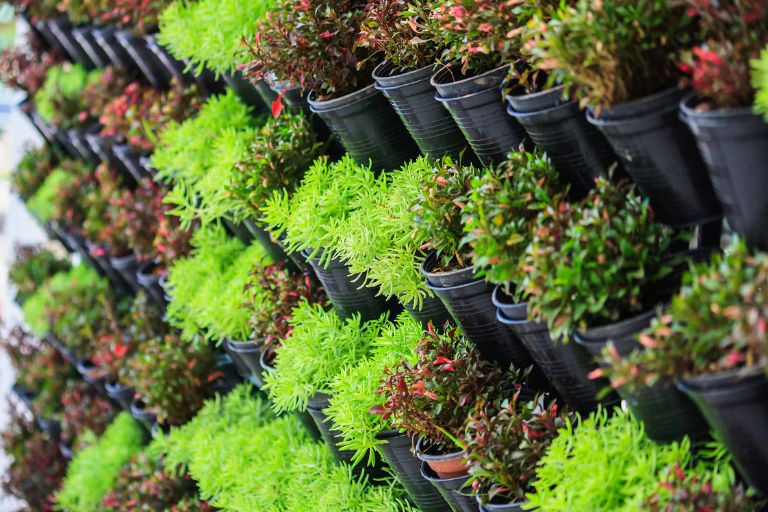
Setting Up Your Vertical Garden in the Garage
When it comes to vertical gardening in the garage, there are several types of systems you can use to grow your plants. Some of the most popular ones are:
Wall-Mounted Planters – Wall-mounted planters are a great option for those who want to save space in their garage. These planters can be mounted directly onto a wall, allowing you to grow plants vertically without taking up floor space. They come in a variety of sizes and materials including metal, plastic and wood.
Hanging Baskets – Hanging baskets are another popular option for vertical gardening in the garage. These baskets can be hung from the ceiling or attached to a wall bracket, allowing you to grow plants at eye level. They are great for trailing plants and can add a lot of visual interest to your indoor garden.
Freestanding Shelves – Freestanding shelving is a great option for those with more space in their garage. These shelves can hold a variety of plants and can be arranged in any way you like. They come in a variety of sizes and materials including metal, wood and plastic.
Trellises – Trellises are a great option for plants that need support, such as tomatoes or cucumbers. These vertical structures can be attached to a wall or freestanding, allowing you to grow plants vertically and save space in your garage.
Pocket Planters – Pocket planters are a newer type of vertical gardening system that is growing in popularity. These planters are made of fabric and have multiple pockets that can be filled with soil and plants. They can be hung from the ceiling or attached to the wall and are a great option for small spaces.
There are several types of vertical gardening systems available for use in the garage, including wall-mounted planters, hanging baskets, freestanding shelves, trellises and pocket planters. Each system has its own advantages and disadvantages, so it’s important to choose the one that best suits your needs and space constraints.
Creating an indoor garden in your garage requires careful planning and attention to detail. Some tips to help you get started include:
Lighting – Most plants need plenty of light to grow well, so it’s important to choose the right lighting for your indoor garden. In the garage, you may need to supplement natural light with artificial light to make sure your plants get enough light. LED grow lights are a popular option for indoor gardening as they are energy efficient and provide a wide spectrum of light that is beneficial for plant growth. Ensure that your lights are positioned approximately 6-12 inches above your plants and adjust the height as your plants grow.
Soil – Choosing the right soil is important for the success of your indoor garden. Most plants thrive in a well-drained soil that is rich in nutrients. You can buy potting soil specially formulated for indoor gardening, or make your own by mixing equal parts peat moss, perlite and vermiculite. Avoid using garden soil as it may contain pests, diseases and weed seeds.
Moisture Levels – The right level of moisture is essential for the health of your plants. Most plants prefer soil that is moist but not waterlogged. Overwatering can lead to root rot and other problems, while underwatering can cause your plants to wilt and die. Water your plants when the top inch of soil feels dry to the touch, and make sure you use a pot with drainage holes to prevent water from collecting in the bottom.
Temperature and Humidity – Temperature and humidity also play a role in the health of your indoor garden. Most plants do well in temperatures between 65 and 75 degrees Fahrenheit, with humidity levels between 40 and 60%. You can use a humidifier to increase humidity levels or mist your plants regularly with water.
Maintenance – Regular maintenance is important for the health of your indoor garden. Check your plants regularly for pests, diseases and nutrient deficiencies. Prune your plants as needed to encourage healthy growth and remove dead or damaged foliage. Feed your plants every 2-4 weeks with a balanced fertilizer to ensure they have the nutrients they need to grow well.
Maintenance and Care of Your Indoor Garden
Regular maintenance is crucial to the success of your garage garden. Here are some reasons why:
Watering – Proper watering is essential for the health of your plants. Most plants prefer soil that is moist but not waterlogged. Overwatering can lead to root rot and other problems, while underwatering can cause your plants to wilt and die. Be sure to water your plants when the top inch of soil feels dry to the touch, and use a pot with drainage holes to prevent water from collecting in the bottom.
Fertilising – Fertilising your plants regularly can help ensure they have the nutrients they need to grow well. Most plants do well with a balanced fertiliser that contains equal amounts of nitrogen, phosphorus and potassium. You can feed your plants every 2-4 weeks during the growing season or as recommended by the manufacturer.
Pruning – Pruning your plants as needed can help encourage healthy growth and remove dead or damaged leaves. Make sure you use clean, sharp scissors or pruning shears to avoid damaging your plants.
Pest and Disease Control – Regular monitoring of your plants for pests and diseases is important to prevent and treat problems before they become too serious. Keep an eye out for common pests such as spider mites, aphids and mealybugs and use organic or chemical treatments to control them as necessary.
Adjusting Lighting and Temperature – As your plants grow and the seasons change, you may need to adjust your lighting and temperature to ensure your plants continue to thrive. Ensure that your lights are positioned approximately 6-12 inches above your plants and adjust the height as your plants grow. Keep an eye on temperature and humidity levels and use a humidifier or fan if necessary to maintain the right conditions for your plants.
Regular maintenance is essential for the health and vitality of your garage garden. Make sure you water and fertilise your plants regularly, prune as necessary, check for pests and diseases, and adjust lighting and temperature as required.
Indoor gardening can be a wonderful hobby, but it can also come with its own set of challenges, including pests and diseases. Some tips on how to identify and deal with common indoor gardening problems include:
Pest Problems – Common indoor garden pests include spider mites, aphids, mealy bugs and whiteflies. Look for signs of pests such as webbing, sticky residue or yellowing leaves. If you notice an infestation, you can try to remove the pests by hand or with insecticidal soap or oil. For heavy infestations, you may need to use a chemical insecticide. Be sure to follow the manufacturer’s instructions and take appropriate safety precautions.
Disease Problems – Indoor plants can be susceptible to fungal, bacterial and viral diseases. Look for signs of disease such as brown or yellow spots on leaves, wilting or stunted growth. If you suspect disease, remove and dispose of the affected plant or leaves. Make sure your plants are well ventilated and avoid overwatering, which can lead to fungal growth.
Nutrient Deficiencies – Indoor plants can sometimes develop nutrient deficiencies if they are not getting enough of the essential minerals they need to grow. Signs of nutrient deficiency can include yellowing leaves, stunted growth or poor fruit or flower production. To remedy nutrient deficiencies, you can add a balanced fertiliser to your plant’s soil or water, or use a special nutrient supplement.
Lighting Issues – If your plants do not get enough light, they may become leggy, pale or weak. Conversely, if they get too much light, they may develop scorched or brown leaves. Make sure your plants are in a location that receives the right amount and quality of light for their specific needs. If necessary, you can supplement natural light with artificial grow lights.
Temperature and Humidity Issues – Indoor plants can be sensitive to temperature and humidity fluctuations. Make sure to maintain a consistent temperature and humidity level in your indoor gardening space, and use a humidifier or dehumidifier as needed to achieve the right conditions for your plants.
Identifying and dealing with common indoor gardening problems requires regular monitoring and attention to detail. Make sure to keep an eye out for signs of pests, disease, nutrient deficiencies, lighting problems, and temperature and humidity issues so you can help your indoor garden thrive.
Vertical gardening in the garage is a great way to maximise space and grow a variety of plants, especially for those who have limited outdoor space or live in areas with harsh weather conditions. With the right lighting, soil and maintenance, you can successfully grow herbs, greens and succulents in your garage. There are many different types of vertical gardening systems to choose from, including wall-mounted planters, hanging baskets and freestanding shelves. However, it’s important to keep an eye out for common garage gardening problems, such as pests and diseases, and treat them promptly to keep your plants healthy. With a little planning and effort, you can create a thriving indoor garden in your garage that will not only beautify your space, but also provide you with fresh herbs and greens for cooking and other uses.
